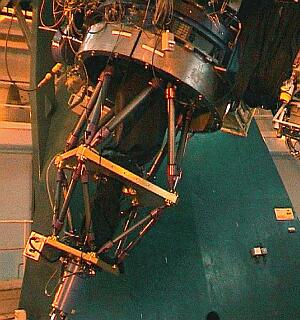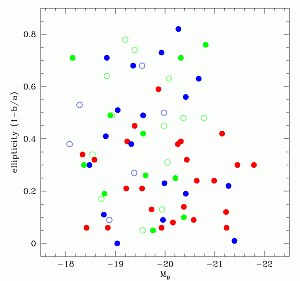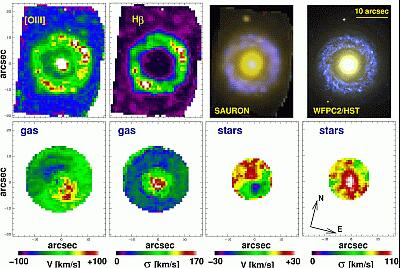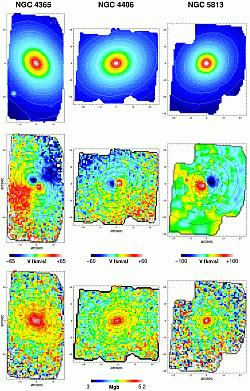- Bacon, R., et al., 1995, A&AS, 113, 347. Citation in text | ADS
- Bacon, R., Emsellem, E., Copin, Y., Monnet, G., 2000, in Imaging the Universe in Three Dimensions, eds W. van Breugel & J. Bland-Hawthorn, ASP Conf. Ser., 195, 173. Citation in text | ADS
- Bacon, R., Emsellem, E., Combes, F., Copin, Y., Monnet, G. & Martin, P., 2001a, A&A, 371, 409. Citation in text | ADS
- Bacon, R. et al., 2001b, MNRAS, 326, 23. Citation in text | ADS
- Bender, R., 1988, A&A, 202, L5. Citation in text | ADS
- Colless, M., et al., 2001, submitted to MNRAS (astro-ph/0107197). Citation in text | LANL
- Davies, R. L., Kuntschner, H., Emsellem, E., Bacon, R., Bureau, M., Carollo, C. M., Copin, Y., Miller, B. W., Monnet, G., Peletier, R. F., Verolme, E. K., de Zeeuw, P. T., 2001, ApJ, 548, L33. Citation in text | ADS
- de Vaucouleurs, G., Buta, R., 1980, AJ, 85, 637. Citation in text | ADS
- Efstathiou, G., Ellis, R. S., Carter, D., 1980, MNRAS, 193, 931. Citation in text | ADS
- Franx, M., Illingworth, G. D., Heckman, T., 1989, ApJ, 344, 613. Citation in text | ADS
- Goudfrooij, P. & Emsellem, E., 1996, A&A, 306, L45. Citation in text | ADS
- Hau, G. K. T., Carter, D., & Balcells, M., 1999, MNRAS, 306, 437. Citation in text | ADS
- Ho, L. C., Filippenko, A. V., Sargent, W. L. W., 1997, ApJS, 112, 315. Citation in text | ADS
- Kuntschner, H., Davies, R. L., 1998, MNRAS, 295, L29. Citation in text | ADS
- Rix, H.-W., de Zeeuw, P. T., Cretton, N., van der Marel, R. P., Carollo, C. M., 1997, ApJ, 488, 702. Citation in text | ADS
- Roberts, M., Hogg, D., Bregman, J., Forman, W., Jones, C., 1991, ApJS, 75, 751. Citation in text | ADS
- Schwarzschild, M., 1979, ApJ, 232, 236. Citation in text | ADS
- Vazdekis, A., 1999, ApJ, 513, 224. Citation in text | ADS
- Wagner, S. J., Bender, R., Möllenhoff, C., 1988, A&A, 195, L5. Citation in text | ADS
- Wozniak, H., Friedli, D., Martinet, L., Martin, P., Bratschi, P., 1995, A&AS, 111, 115. Citation in text | ADS
- de Zeeuw, P. T., Franx, M., 1991, ARA&A, 29, 239. Citation in text | ADS
- de Zeeuw, P. T., et al., 2000, ING Newsletter, 2, 11. Citation in text | ADS
- de Zeeuw, P. T. et al., 2001, MNRAS, submitted. Citation in text
| THE ING NEWSLETTER | No. 5, October 2001 |
|
|
SCIENCE |
|
|
|
| Previous: | The Andromeda Stream: A Giant Trail of Tidal Stellar Debris in the Halo of M31 | Up: | Table of Contents | Next: | The Central Kiloparsec of Starbursts and AGN: The La Palma Connection |
Other available formats: PDF
The SAURON Survey of Early-Type Galaxies in the Nearby Universe
R. F. Peletier1, R. Bacon2, M. Bureau3, M. Cappellari3, Y. Copin3, R. L. Davies4, E. Emsellem2, J. Falcón-Barroso1, D. Krajnovic3, H. Kuntschner4, R. McDermid4, B. W. Miller5, E. K. Verolme3, F. Wernli2 and P. T. de Zeeuw3
1: University of Nottingham. 2: Observatoire de Lyon. 3: Sterrewacht Leiden. 4: Durham University. 5: International Gemini Project.
In
1999, a new and unique integral-field spectrograph, SAURON, made its debut
at the WHT. SAURON has a large field of view and high throughput, and was
developed as a private instrument in a collaborative effort between groups
at Observatoire de Lyon, Leiden Observatory, and the University of Durham.
It is optimised for the systematic study of the stellar and gaseous kinematics
and the line-strength distributions of nearby early-type galaxies and bulges.
The design of SAURON (Figure 1) is similar to that
of the prototype integral-field spectrograph TIGER and its successor OASIS
built for the CFHT (Bacon
et al., 1995,
2000).
The field of view is 33×41 arcsec with spatial sampling of 0.94×0.94
arcsec. SAURON provides 1,577 spectra in the wavelength range from 4810Å
to 5350Å. Of these, 146 are sky-spectra 1.9 arcmin away from the
main field. A complete description of the design and construction of SAURON,
and the corresponding data reduction software is given in Bacon
et al. (2001b). Details about the commissioning, together with some
early results, can be found in an article in the ING Newsletter
of March 2000 (de
Zeeuw et al., 2000). The article also describes the SAURON project,
an ambitious survey of the dynamics and stellar populations of large, nearby
early-type galaxies and bulges. Here we give a progress report on the survey,
describe what we have been able to do in five observing runs, and what
we plan to do in the near future.
 |
| Figure 1. SAURON at the Cassegrain focus of the WHT. [ JPEG | TIFF ] |
SAURON Project: A Survey of Early-Type Galaxies and Bulges
The aim of the SAURON collaboration, and the reason for building the instrument, is to study a representative sample of nearby ellipticals, lenticulars and bulges of early-type spirals, in order to measure their intrinsic shapes, velocity and metallicity distributions, and to gain insight into the relation between their stellar and gaseous kinematics and stellar populations. The SAURON data will be combined with high spatial resolution spectra of the nuclei, and interpreted through state-of-the-art dynamical and stellar population modelling.
We defined the SAURON sample
in the following way. We first compiled a complete list of accessible E/S0
galaxies and Sa bulges for which SAURON can measure the stellar kinematics:
-6°![]() d
d![]() 64°
(to limit the zenith distance and therefore the instrumental flexure),
cz
64°
(to limit the zenith distance and therefore the instrumental flexure),
cz![]() 3000kms-1
(to ensure that the lines of interest are in the spectral band), and
MB
3000kms-1
(to ensure that the lines of interest are in the spectral band), and
MB![]() 18
(so that
18
(so that ![]() 75
kms-1 and velocity dispersions can be measured). The objects
span a factor 50 in luminosity and cover the full range of environment,
nuclear cusp slope, rotational support, and apparent flattening. The galaxies
were then divided into six categories (E/S0/S; field/cluster) and a representative
sample of 12 objects was selected in each category to populate the ellipticity
versus absolute magnitude planes homogeneously (see Figure
2). Since we are trying to observe each galaxy to one half-light radius,
we took multiple-pointing mosaics for many of our objects, thus ensuring
the internal structure of these galaxies is fully mapped to large scales.
75
kms-1 and velocity dispersions can be measured). The objects
span a factor 50 in luminosity and cover the full range of environment,
nuclear cusp slope, rotational support, and apparent flattening. The galaxies
were then divided into six categories (E/S0/S; field/cluster) and a representative
sample of 12 objects was selected in each category to populate the ellipticity
versus absolute magnitude planes homogeneously (see Figure
2). Since we are trying to observe each galaxy to one half-light radius,
we took multiple-pointing mosaics for many of our objects, thus ensuring
the internal structure of these galaxies is fully mapped to large scales.
 |
| Figure 2. Galaxies of the SAURON survey in the luminosity —ellipticity plane. Galaxies that have been observed to date are shown with filled symbols. Red dots are elliptical galaxies, blue dots are S0's and green dots denote the spirals. [ GIF | TIFF ] |
We are making excellent progress. We have had 5 observing runs, and observed a total of ~50 galaxies. More than half our objects were observed during an exceptionally good run in March, 2001. Of a total of 12 nights allocated by British and Dutch committees we lost only about 3 hours due to technical problems, and none to weather. Exceptional conditions were coupled with the excellent performance of the new ULTRADAS readout system recently installed at La Palma, which has more than halved readout times and overheads, adding 30–60 minutes of usable time per night. This run enabled us to finish our subsample of elliptical galaxies, and to almost complete the S0-subsample. The efficiency of observing with SAURON in this run also reflects the first-class support offered by the ING staff, and illustrates how well the instrument has been integrated into the observatory. We have now taken ~115,000 independent galaxy spectra, a similar number to, e.g., the 2dF survey (Colless et al., 2001).
Although one might think that the data reduction for an instrument like SAURON, with dataframes containing about 1,600 spectra each, is exceedingly complicated, the fact that almost everything in SAURON is fixed makes the data reduction the same for each galaxy. For this reason it has been possible to build an automatic reduction pipeline, named Palantir, which converts the data from raw CCD-frames to calibrated data-cubes. Palantir uses individual programs of the XSAURON software, developed in Lyon in a way similar to the XOASIS package. After analysing in detail part of the data we find that the SAURON measurements are comparable to, and usually significantly better than, the highest-quality determinations in the literature (de Zeeuw et al., 2001).
Science with SAURON
The information contained in the SAURON spectra can be divided roughly in three classes: stellar kinematics, absorption line-strengths, and gaseous kinematics and emission line-strengths. In the following we show examples of all three classes, and how the data can be used to better understand the formation and evolution of early-type galaxies.
Counter-rotating Gas in the Spiral Galaxy NGC7742
NGC7742 is a nearly face-on spiral galaxy classified as S(r)b in the RC3 (MB=–20.99), and it is an example of the latest type spirals included in our sample. The galaxy contains an inner stellar ring with bright HII regions, flocculent spiral arms, a significant amount of neutral hydrogen, molecular gas, and dust (de Vaucouleurs & Buta, 1980; Roberts et al., 1991; Wozniak et al., 1995). The nucleus is classified as a transition LINER/HII object (Ho et al., 1997).
Figure
3 shows SAURON maps based on a single pointing taken on October 13,
1999. Most of the H![]() and [OIII] emission is confined to the ring of star
formation surrounding the bulge. H
and [OIII] emission is confined to the ring of star
formation surrounding the bulge. H![]() is dominant everywhere in the ring, where the ratio [OIII
5007Å]/H
is dominant everywhere in the ring, where the ratio [OIII
5007Å]/H![]() ranges
from 0.06 to 0.14. In the center the ratio is larger than 20. Figure
3 also shows a colour-coded reconstructed SAURON image, and an image
based on broadband HST/WFPC2 images. The SAURON map does not have the spatial
resolution of HST, but it does demonstrate that our analysis technique
is capable of providing accurate emission-line maps.
ranges
from 0.06 to 0.14. In the center the ratio is larger than 20. Figure
3 also shows a colour-coded reconstructed SAURON image, and an image
based on broadband HST/WFPC2 images. The SAURON map does not have the spatial
resolution of HST, but it does demonstrate that our analysis technique
is capable of providing accurate emission-line maps.
The bottom panels of Figure
3 show the mean velocity and velocity dispersion fields of the gas
and stars in NGC7742. The galaxy is observed almost face-on, and the amplitude
of the velocities is accordingly modest. The zero-velocity directions are
well-defined, and their position angles are consistent with each other
(PA = 42°±12° for the stars and 35°±5° for
the gas). However, gas and stars rotate in the opposite sense. This suggests
that the observed gas does not originate from the stars, but has most likely
been accreted.
 |
| Figure 3. SAURON measurements of NGC7742,
based on 1 pointing, exposed for 4×1800s. The top panels show the
emission-line intensity distributions of [OIII] and
H |
The Stellar Populations of Galaxies with Kinematically-Peculiar Cores
Until the mid 1970s elliptical galaxies were thought to be smooth, structureless, red objects containing only old stars. Through the development of larger telescopes, coupled with improved detectors and better instrumentation, it has become apparent that this picture is far from correct. It was found that luminous ellipticals rotate very slowly. They do not maintain their ellipsoidal shape as a result of rotation, but are supported by an anisotropic stellar velocity distribution. Several indications were found that elliptical galaxies were the results of mergers of spiral galaxies. Many ellipticals contain significant fractions of interstellar matter, and not all stars were formed at the same time.
Of order 30% of the nearby elliptical galaxies contain a hint of so-called Kinematically Decoupled Core (KDC), i.e., a central component in which the stars rotate in a different sense to the stars in the main body of the galaxy. This can range from a simple counter-rotating component to a component with a skewed rotation axis. It is now thought that KDC's are formed in the last episode of major star formation of a galaxy. The fact that the orientation of their rotation is different from most of the stars indicates that this burst must have been induced by a galaxy merger (e.g., de Zeeuw & Franx, 1991). For a few galaxies the stars in the KDC have been studied in reasonable detail, to find out when they were formed, e.g., soon after the formation of the bulk of the galaxy, or later, during a minor merger event. Most KDC's seems to have the same age as the host galaxy (e.g., NGC5322, Bender, 1988), while some show evidence for very recent star formation (e.g., NGC2865, Hau et al., 1999).
SAURON is the ideal instrument to study KDC's. It provides the orientation of the rotation of the KDC with respect to that of the main galaxy with an accuracy that is nearly impossible to achieve with long-slit spectroscopy along multiple position angles. At the same time it provides line-strength maps, which can be used to study the ages of both components. Another non-negligible advantage is that with SAURON one can very accurately compare the kinematic and photometric centres. If they are different, as is, e.g., the case for M31 (Bacon et al., 2001a), a long-slit spectrum through the photometric centre of the galaxy does not necessarily catch the kinematic centre, and is therefore very hard to interpret. Our sample of galaxies observed to date contains three elliptical galaxies for which previous work had demonstrated a dramatic KDC: NGC4365, 4406 and 5813 (resp. Wagner et al., 1988; Franx, Illingworth & Heckman, 1989; Efstathiou, Ellis & Carter, 1980). All three objects have a flat central surface brightness profile (a core) of a few arcseconds in size, after which the surface brightness starts to fall rapidly (Figure 4, top). Apart from this, there is no photometric indication of the presence of a KDC.
The velocity fields, however,
are not regular at all (Figure 4). For both NGC4365
and NGC4406 the main body of the galaxy rotates around the major axis,
while the KDC rotates approximately around the minor axis. NGC5813 contains
a rapidly rotating central component, has negligible rotation beyond that,
and shows weak evidence of minor axis rotation. In none of the cases is
the misalignment of photometric and kinematic major axes exactly 90°,
which would be expected if the galaxies were fully axisymmetric ellipsoidal
objects. This means that probably all three are triaxial. An important
advantage of SAURON is that one obtains at the same time a number of absorption-line
maps, which are excellent indicators of the age and metallicity of the
stellar populations. In the wavelength region between 4810 and 5350Å
that is covered by SAURON, there are various features (e.g., H![]() ,
Mg b and Fe 5270) that can be used to derive constraints on the age and
metallicity of the stars at every position.
,
Mg b and Fe 5270) that can be used to derive constraints on the age and
metallicity of the stars at every position.
 |
Figure 4. Top row: Reconstructed intensity maps of NGC4365, 4406 and 5813. Middle row: Radial velocity maps of the three galaxies. Bottom row: Mgb line-strength maps. The data for NGC4365 consist of a mosaic of two SAURON pointings, observed on March 29 and 30, 2000. NGC4406 was observed on March 20, 2001, and consists of three pointings. NGC5813 was observed on March 29 and 30, 2000 and on April 4, 2000, with two pointings. All pointings consist of four exposures of 1800 seconds each. [ JPEG | TIFF ] |
In Davies
et al. (2001), we present a detailed analysis of the stellar populations
in the region of the KDC of NGC4365. As can be seen from Figure
4 (bottom) the KDC is not visible in the Mg b maps. The same can be
said for other line-strength maps like H![]() .
The Mg b line-strength increases towards the centre, following the isophotes.
H
.
The Mg b line-strength increases towards the centre, following the isophotes.
H![]() is more or less
constant for the whole galaxy. When one compares the data with stellar
population models one sees that the centre is about 2 Gyr younger than
the rest of the galaxy (Figure 5). The stellar populations
on the major axis (in the KDC) however, are the same as the ones on the
minor axis at the same deprojected distance, perpendicular to the KDC (the
red and green point are in the same place). The main body of the galaxy
and the KDC are indistinguishable in age. This analysis shows that the
process which formed the KDC induced star formation everywhere in the central
regions. The newly formed stars have the highest metallicities, showing
that they were formed from interstellar matter processed by stars in the
galaxy itself, rather than from material that was captured from outside.
For NGC4406 and NGC5813 we find a similar stellar population structure.
Mg b is enhanced everywhere in the inner regions, not just in the region
of the KDC. For NGC5813 the measurement of H
is more or less
constant for the whole galaxy. When one compares the data with stellar
population models one sees that the centre is about 2 Gyr younger than
the rest of the galaxy (Figure 5). The stellar populations
on the major axis (in the KDC) however, are the same as the ones on the
minor axis at the same deprojected distance, perpendicular to the KDC (the
red and green point are in the same place). The main body of the galaxy
and the KDC are indistinguishable in age. This analysis shows that the
process which formed the KDC induced star formation everywhere in the central
regions. The newly formed stars have the highest metallicities, showing
that they were formed from interstellar matter processed by stars in the
galaxy itself, rather than from material that was captured from outside.
For NGC4406 and NGC5813 we find a similar stellar population structure.
Mg b is enhanced everywhere in the inner regions, not just in the region
of the KDC. For NGC5813 the measurement of H![]() is complicated by strong emission lines from gas in the inner regions of
this galaxy (see our analysis in de Zeeuw
et al., 2001). Using a technique described in Goudfrooij
& Emsellem (1996) we have been able to separate absorption from
emission, and find that H
is complicated by strong emission lines from gas in the inner regions of
this galaxy (see our analysis in de Zeeuw
et al., 2001). Using a technique described in Goudfrooij
& Emsellem (1996) we have been able to separate absorption from
emission, and find that H![]() does not change in the inner 10 arcsec, similar to NGC4365.
does not change in the inner 10 arcsec, similar to NGC4365.
![[MgFe52] vs H-beta](sauron5s.gif) |
| Figure 5. The [MgFe52] (= |
Next Steps
We are at present at a crucial stage of the SAURON project. From the outset (de Zeeuw et al., 2000) we hoped to have the observations of the whole sample completed in the spring of 2002. We are on track, and if time is allocated and the weather is cooperative, we will succeed. At present two papers have appeared in refereed journals, one has been submitted, and more than half a dozen conference proceedings have appeared as well. Several publications about individual objects and subsamples are in preparation. The highest priority now is to keep up with the data analysis. To do this, several subteams are investigating various aspects of the data: the dynamics, the stellar populations, the link between the two, the properties of the ionised gas, the early-type galaxies and the bulges, etc. The detailed measurements for individual objects will be compared with fully general galaxy models constructed by means of Schwarzschild's (1979) numerical orbit superposition method (cf. Rix et al., 1997). The modelling uses all appropriate imaging and spectral data that are available, including HST and OASIS spectra, to constrain the mass of a central black hole and the orbital structure in the main body of the galaxy. When combined with the constraints on the stellar populations derived from the line-strength distributions (Kuntschner & Davies, 1998), this will shed new light on the fundamental connections between the large and small scale dynamics, the formation (and existence) of supermassive BHs and galactic nuclei, and the history of metal enrichment in early-type galaxies and bulges.
Acknowledgements
It is a pleasure to thank
the ING staff, in particular René Rutten, Tom Gregory and Chris
Benn for enthusiastic and competent support on La Palma. The SAURON project
is made possible through financial contributions from NWO, the Institut
National des Sciences de l'Univers, the Université Claude Bernard
Lyon I, the Universities of Durham and Leiden, and PPARC.
References:
Email contact: Reynier Peletier (Reynier.Peletier@nottingham.ac.uk)
| Previous: | The Andromeda Stream: A Giant Trail of Tidal Stellar Debris in the Halo of M31 | Up: | Table of Contents | Next: | The Central Kiloparsec of Starbursts and AGN: The La Palma Connection |
| GENERAL | SCIENCE | TELESCOPES AND INSTRUMENTATION | OTHER NEWS FROM ING | TELESCOPE TIME |